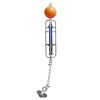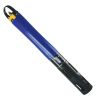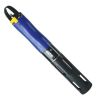NexSens EXO Sonde Mooring Cages
Features
- Integrated mooring clamps sized specifically for EXO sondes
- Hinged pin design allows for quick clamping and release
- Rugged stainless steel frame and PVC clamp construction
- Free ground shipping
- Expedited repair and warranty service
- Lifetime technical support
- More
The NexSens EXO Sonde Mooring Cages provide a secure and convenient means of deploying a YSI EXO multi-parameter water quality sonde. The cage features a 316 stainless steel construction with top and bottom 3/4" eyenuts. The convenient eyenut connection allows the cage to be deployed in-line on an open water buoy mooring or mounted horizontally on a riverbed.
Two integrated PVC mooring clamps are designed specifically for the diameter of a YSI EXO1, EXO2 or EXO3 sonde. Each clamp features a hinged pin design for quick clamping and release. The clamps are positioned at the optimal clamp areas of an EXO sonde so as not to deform the instrument.
An optional mounting crossarm is available for adding photosynthetically active radiation (PAR) sensors. The crossarm allows for both upwelling and downwelling sensors with optional anti-fouling wipers. For saltwater applications, sacrificial zinc shaft anodes are available to attach to the cage and mitigate corrosion during long-term deployments.
- Dimensions: 42" long, 12" diameter
- Weight: 16 lbs.
- Material: 316 SS frame, 316 SS eyenuts, PVC clamps
- Mooring Attachments: (2) 3/4” eyenuts
In The News
Floating Global New Ideas: Buoy-Enabled Research at Florida Agricultural and Mechanical University’s School of the Environment
Florida Agricultural and Mechanical University (FAMU), based in Tallahassee, Florida, is the highest-rated public Historically Black College or University in the United States. FAMU’s School of the Environment (FAMU-SOE) offers BS and BA degrees in Environmental Studies, and BS, MS, and Ph.D. degrees in Environmental Science, with specialisms available in areas including Environmental Policy and Risk Management, Aquatic and Terrestrial Ecology, and Biomolecular Sciences. In 2021, FAMU-SOE deployed a NexSens CB-450 buoy in Apalachee Bay, a key oyster farming area around 30 miles south of Tallahassee. The buoy has quickly been incorporated into the curriculum, providing environmental insights for student research, the community, and beyond. Dr.
Read MoreMonitoring Habitat Suitability and Water Quality in Northwest Arkansas Springs
Northwest Arkansas has seen an economic, industrial, and population boom in recent years as a result of expanding businesses, which have created thousands of jobs in the region and the mass migration of employees and construction companies. However, with this growth has come rapid urbanization and the degradation of the natural landscape, specifically the freshwater springs that can be found throughout the region. These springs are critical habitat centers for native wildlife, home to threatened and endangered fish, and those that have yet to be listed. Zach Moran, Assistant Professor of Fisheries Science at Arkansas Technical University, is working to help monitor these habitats and provide key data that will hopefully inform future development in the region.
Read MoreThree Decades of Research at Acton Lake
A multi-disciplinary team at Miami University, Ohio, has been studying the environmental change at Acton Lake for over three decades. Using three different NexSens buoys over this time, the team has an incredible archive of data that is helping build a picture of Acton’s past, present, and future. Until recently, a NexSens CB-50 buoy was used alongside other environmental monitoring at Acton Lake. In May 2025, the Miami team deployed a new XB-200 buoy , future-proofing their ongoing monitoring using real-time buoy systems. Acton Lake, a small hypereutrophic reservoir in southwest Ohio, covers 2.4km² and has a maximum depth of about 8m. The dam was built in 1956, and the lake has a large agricultural watershed.
Read More













